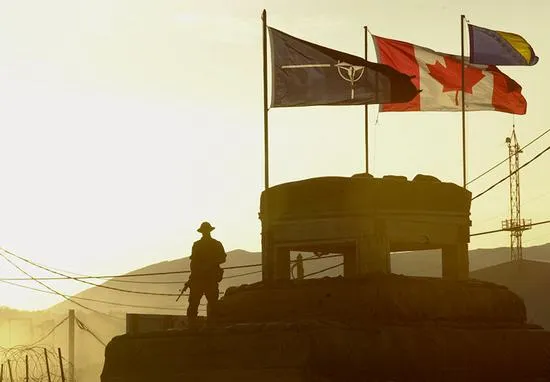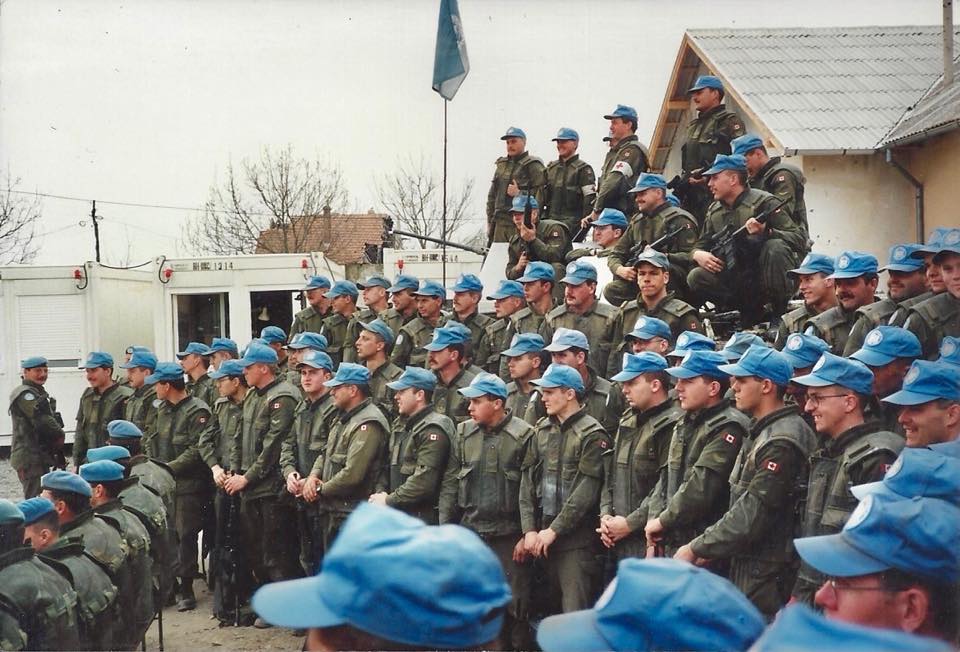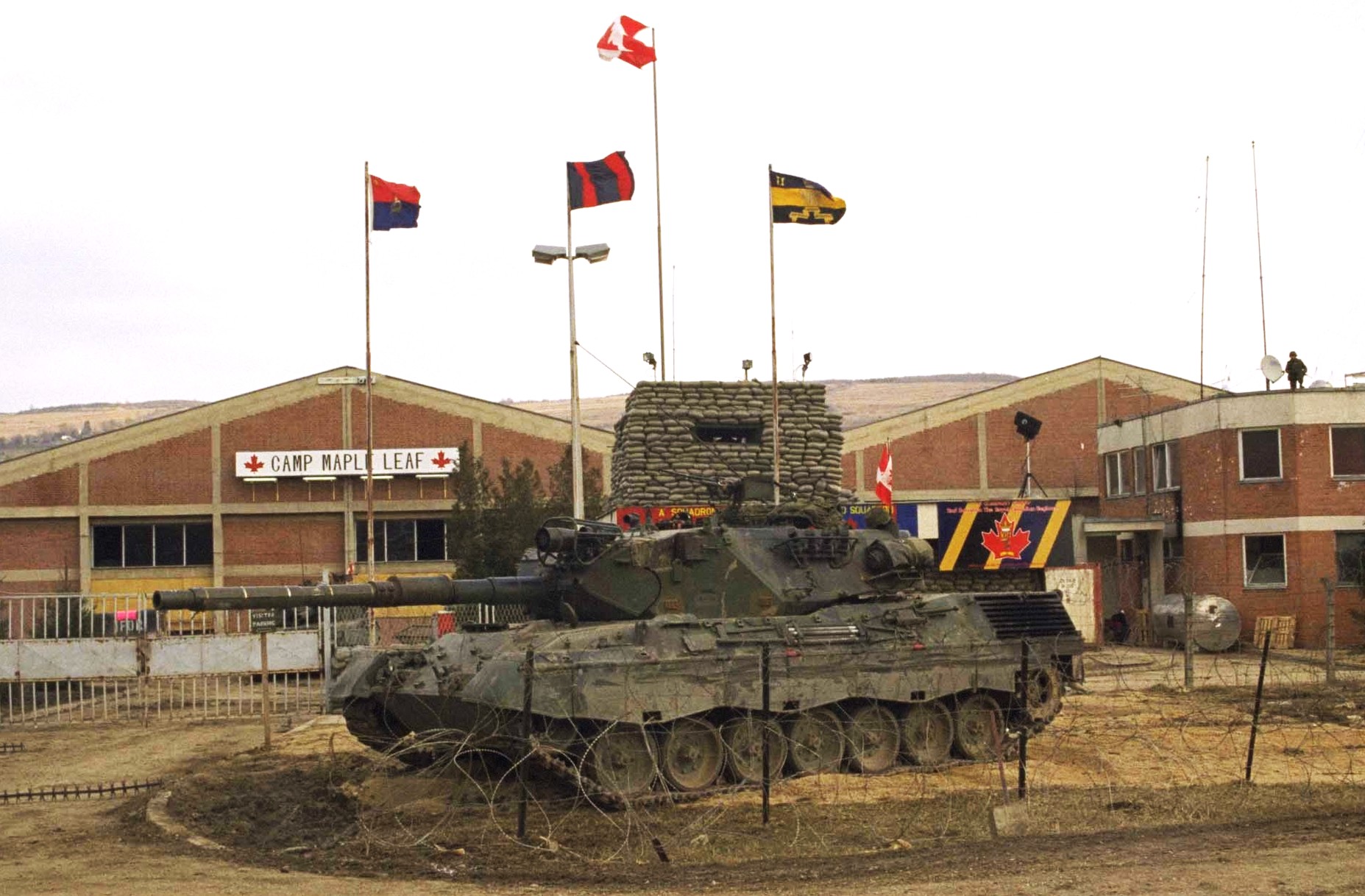Balkans 35th Commemoration
January 2026 to November 2027
The Balkans 35th Commemoration is a volunteer Veteran led initiative. Our aim is to acknowledge Balkans Veterans from all elements of the Canadian Armed Forces (CAF), the Royal Canadian Mounted Police (RCMP), other Canadian Police forces, Canadian Border Services Agency (CBSA) and Canadian International Development Agency (CIDA) who deployed to the Balkans from 1992 to 2004.
We are in the process of translating this website. Nous sommes en trainde traduire ce site Web.


A Decade of Duty: Canada's Role in the Balkans
40,000 Canadians served in the Balkans, and 23 died there, between 1991 and 2010 on various peace support missions in the aftermath of the dissolution of the former Yugoslavia. These deployments occurred under the umbrella of European Community, United Nations (UN), and North Atlantic Treaty Organization (NATO) mandates in countries like Bosnia-Herzegovina, Croatia, Macedonia, and Serbia.
.webp)
1989
The Berlin Wall comes down, heralding the collapse of Communism in eastern Europe and the end of the Cold War. The Warsaw Pact and the Union of Soviet Socialist Republics (USSR) splinter into independent nations.
1991
- June. Slovenia and Croatia declare their independence from Yugoslavia.
- European Community Monitor Mission (ECMM) deploys monitors to Slovenia, then to Croatia (and later to Bosnia as well). Canada's contribution of 15 monitors (1991-1994) is known as Operation BOLSTER.
- Fighting erupts in Croatia between Croats and Serbs, as well as federal units of the Jugoslav National Army (JNA), located in the Croatian border regions of the Krajinas and Slavonia.
- United Nations military observers (UNMOs) deploy to Croatia (and later to Bosnia)
1992
- February. The United Nations Protection Force I (UNPROFOR I) is created to stabilize the situation in Croatia.
- April. UNPROFOR's 12 battalions from various nations deploy to the newly-created United Nations Protected Areas (UNPA) in the Krajinas and Slavonia. These areas are demilitarized and the UN commits to protecting their populations from further fighting. These are divided into four sectors: Sector South, Sector North, Sector East, and Sector West. Canada's rotating contribution of one 850-person battalion (known as Canadian Battalion One or CANBAT 1), as well as a 250-person combat engineer regiment, is designated Operation HARMONY. (The engineer commitment was later reduced to a composite field squadron.)
- June. Three-way fighting begins between Bosnian Muslims, Croats, and Serbs in Bosnia-Hercegovina. The situation in Sarajevo, where UNPROFOR headquarters is located, deteriorates rapidly.
- June-July. Canadian troops (1er Bataillon, Royal 22e Régiment, augmented by November Company, 3rd Battalion, Royal Canadian Regiment) deploy from their base in Sector West (Croatia) to open Sarajevo airport. For these actions, 1 R22R was subsequently awarded the Commander-in-Chief's Unit Commendation, created by Governor General Adrienne Clarkson in 2002.
- September. UNPROFOR II is created in part to facilitate the delivery of humanitarian aid throughout Bosnia via convoys from its airhead in Sarajevo. It expands to 19,000 military personnel from at least ten countries, organized in 14 battalions.
- Canada's contribution to UNPROFOR II is known as Operation CAVALIER. It consists of a 1200-person rotating light armoured regiment (ie, not including tanks), augmented by infantry, engineers, and other specialists like a field surgical team (FST). It is known as CANBAT 2.
- Logistic support was provided initially by a 36-person National Support Element based in Croatia. This was later expanded to become a 113-person Canadian Contingent Support Group (CCSG), and then a 271-person Canadian Logistics Battalion or CANLOGBAT. The NSE and CCSG operated from Camp Pollom in Daruvar, Croatia.
- Members of the Royal Canadian Mounted Police serve with the United Nations Civilian Police (UNCIVPOL), monitoring belligerent police forces.
1993
- January. CANBAT 2 deploys a company to Macedonia to help deter adjacent nations (eg, Serbia, Bulgaria and Albania) from interfering in its affairs
- April. North Atlantic Treaty Organization (NATO) aircraft begin enforcing a no-fly zone over Bosnia in Operation DENY FLIGHT.
- May. The UN designates six UN Safe Areas in Bosnia: Sarajevo, Tuzla, Zepa, Gorazde, Bihac, and Srebrenica.
- Summer. CANBAT 1 moves from Sector West to Sector South in Croatia. The CCSG moves from Daruvar to Sibinek and Primosten in southern Croatia.
- June. Warships from NATO nations, including Canada, and the Western European Union (WEU) enforce an arms embargo against the Federal Republic of Yugoslavia (Serbia and Montenegro) in the Adriatic Sea as part of Operation SHARP GUARD through to May 1996. NATO aircraft as part of Op DENY FLIGHT are now authorized to provide close air support to UN troops.
- 15-16 September. Soldiers from Second Battalion, Princess Patricia's Canadian Light Infantry (2 PPCLI) engage Croat forces in a firefight in order to prevent ethnic cleansing of the Serb minority population of the Medak Pocket in Sector South. Four Canadians are wounded and an estimated 27 Croatians are killed. This was Canada's most significant combat action since the Korean War (1950-1953). For this action, 2 PPCLI was subsequently awarded the Commander-in-Chief's Unit Commendation.
1994
- February-March. UN establishes Sarajevo Exclusion Zone, and NATO threatens airstrikes, in an attempt to compel Serbian forces to remove their heavy weapons from the area surrounding the city
- February. United States Air Force jets shoot down four Serbian aircraft near Banja Luka.
- April. NATO aircraft fly close support missions against Serbian forces surrounding the UN Safe Area of Gorazde.
- Bosnian Croats and Bosnian Muslims sign a ceasefire agreement with each other, forming a joint command to oppose the Bosnian Serbs.
1995
- March. UNPROFOR is restructured into three missions: UNPROFOR in Bosnia-Herzegovina, UN Confidence Restoration Organization (UNCRO) in Croatia, and UN Preventive Deployment Force (UNPREDEP).
- July. Bosnian Serb forces attack the UN Safe Area of Srebrenica and kill 8,000 Bosnian Muslim civilians in the Srebrenica Massacre.
- August-September. NATO aircraft attack Bosnian Serb forces in a widespread air campaign during Operation DELIBERATE FORCE.
- August. During Operation STORM Croatian forces attack and overrun Serbian forces in the Krajina region, defeating the Republic of Serbian Krajina (RSK).
- December. Croatian, Serbian, and Bosnian presidents sign the Dayton Peace Accords, ending the fighting in their countries. To monitor and enforce the peace agreement, Canada contributes 1,000 personnel in two six-month deployments as part of the 60,000-strong NATO-led Implementation Force (IFOR), Operation JOINT ENDEAVOUR.
1996
- The airport at Sarajevo re-opened to civilian air traffic on 16 August 1996. IFOR was replaced by SFOR, Dec. DeinDecemberDDecember
- IFOR was replaced by the NNANATStabilization Force (SFOR) in December 1996. Its role was to create a secure environment for both local authorities and international agencies while Bosnia and Herzegovina became a democratic country. NATO provided about 12,000 troops, including approximately 1,200 Canadians. The CAF provided infantry, armour, engineers, helicopters and support elements on a six-month rotational basis.
- December. IFOR mission ends and transitions to NATO-led Stabilization Force (SFOR) in Bosnia. This 12,000-member force includes about 1200Canadians serving in six-month deployments as part of Operation PALLADIUM.
- Canadian civilian police participate in the UN Mission in Bosnia and Herzegovina (UNMIBH), and later with the European Union Police Mission (EUPM), to assist in maintaining law and order through to 2006.
1998
- March. UNPROFOR is restructured into three missions: UNPROFOR in Bosnia-Herzegovina, UN Confidence Restoration Organization (UNCRO) in Croatia, and UN Preventive Deployment Force (UNPREDEP).
- July. Bosnian Serb forces attack the UN Safe Area of Srebrenica and kill 8,000 Bosnian Muslim civilians in the Srebrenica Massacre.
- August-September. NATO aircraft attack Bosnian Serb forces in a wide spread air campaign during Operation DELIBERATE FORCE.
- August. During Operation STORM Croatian forces attack and overrun Serbian forces in the Krajina region, defeating the Republic of Serbian Krajina (RSK).
- December. Croatian, Serbian, and Bosnian presidents sign the Dayton Peace Accords, ending the fighting in their countries. To monitor and enforce the peace agreement, Canada contributes 1,000 personnel in two six-month deployments as part of the60,000-strong NATO-led Implementation Force (IFOR), Operation JOINT ENDEAVOUR.· Fighting between Serbian forces and ethnic Albanians (the Kosovo Liberation Army or KLA) breaks out in Kosovo
- October. Canada contributes six CF-18 Hornet fighter jets to help enforce a NATO no-fly zone over Bosnia-Herzegovina in Operation DETERMINED FORCE. The intent is to deter Serbian aggression in Kosovo.
1999
- March. NATO mounts Operation ALLIED FORCE, a 78-day bombing campaign to deter Serbia from further aggression in Kosovo. This includes bombing targets in Serbia itself, including within the capital city Belgrade. Canada triples its contribution to 18 Hornets.
- March. NATO establishes Kosovo Force (KFOR) to support UN Mission in Kosovo (UNMIK) in securing and maintaining peace there.
- June. Canada contributes 800 personnel and eight helicopters to KFOR to enforce the peace in Kosovo in Operation KINETIC.
- July. Canada contributes a further 500 infantry and armoured troops, including Leopard tanks, to KFOR.
- Members of the RCMP and 20 other Canadian police organizations participate in UNMIK through to March 2004. Up to 92 officers a year help to keep the peace and train Kosovo police members.
2000
June. Canada ends its troop contributions to KFOR (Op KINETIC) after two six-month rotations.
2001
August-September. Canada contributes 200 personnel to assist with NATO's 4,500-member Operation ESSENTIAL HARVEST. The role of this short mission is to disarm Albanian paramilitary groups operating in the Former Yugoslav Republic of Macedonia (FYROM).
2002
- Governor General Adrienne Clarkson awards the Commander-in-Chief's Unit Commendation to members of 1 R22R (including N Company, 3 RCR) for opening the Sarajevo airport in July 1992, and to members of 2 PPCLI for their actions at Medak in September 1993. The commendation is awarded to a unit "that has performed an extraordinary deed or activity of a rare high standard in extremely hazardous circumstances." These commendations "are restricted to war or war-like conditions in an active theatre of operations" (Department of National Defence).
- A composite reserve infantry company (CRIC) comprising reservists from Western Canada deploys for the first time with First Battalion, Princess Patricia's Canadian Light Infantry to Bosnia on Op PALLADIUM Roto 11 (2002-2003). (Ordinarily, Canadian reservists deploy as individual augmentees, sprinkled throughout a Regular Force unit.) After this, a composite reserve company (CRC) including non-infantry personnel will deploy on future rotations.
2004
- Canada's contribution to SFOR has been reduced to 650 troops per rotation.
- SFOR becomes a European Union mission (EUFOR) by the end of the year. Unit rotations as part of Op PALLADIUM cease. Canada contributes an 85-member liaison and observation team to EUFOR.
2007
March. Canada's involvement with EUFOR ends.
Veterans’ Stories Hub
This space is dedicated to the voices of those who served—and the families who stood with them. Browse a growing library of personal stories, reflections, and shared memories from the Balkans mission. Every story helps preserve the legacy of service and brings connection to those who lived it.
Mental Health Resources
Access support through trusted organizations, peer networks, and crisis services. We are committed to the well-being of those who served and the people who stand beside them.
Events Calendar
The 35th commemoration will include a series of events to honour those who served in the Balkans. From the Garrison Ball to the Warriors Day Parade and other community gatherings, the calendar will be updated as plans are confirmed.
News
Stay informed with updates on upcoming events, media coverage, and project milestones. This space reflects our ongoing commitment to remembrance and community outreach.
About Us
Learn more about the project’s mission, the volunteer committee behind it, and our vision for the 35th commemoration. Transparency, respect, and service guide everything we do.
A Visual Record of Service and Solidarity
Photographs from the Balkans mission and commemorative events capture moments of duty, resilience, and camaraderie. This gallery honours the people behind the service—on the ground and at home—and the legacy they continue to build.
What can you do?
Whether you served or simply want to show your support, there are meaningful ways to get involved.
Share Your Story or Join a Return Trip
Your experience matters. If you served in the Balkans, you’re invited to contribute to our growing archive of personal stories or express interest in returning to the region as part of a future commemorative visit. Every voice adds depth to our collective memory.
Donate to Support the Cause
Help us honour those who served by supporting storytelling initiatives, mental health resources, and commemorative events. Donations go through the Hamilton Galt Memorial Fund and make a lasting impact on this important work.


%20CS%2023%2C%20Visoko%201994.jpg)







